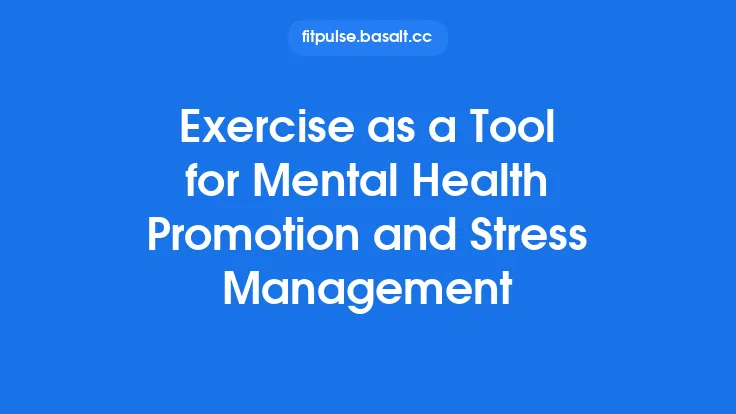Mobility‑limited individuals—whether due to neurological injury, progressive disease, or musculoskeletal impairment—often encounter barriers that make traditional land‑based exercise challenging or unsafe. Water, with its unique physical properties, offers a therapeutic medium that can reduce joint loading, enhance proprioceptive feedback, and enable movement patterns that might otherwise be impossible. By thoughtfully adapting aquatic exercise protocols, clinicians, fitness professionals, and rehabilitation specialists can create inclusive programs that promote cardiovascular health, muscular strength, functional mobility, and psychosocial well‑being for this diverse population.
Physiological Foundations of Aquatic Exercise
Buoyancy and Load Reduction
Archimedes’ principle dictates that an immersed body experiences an upward buoyant force equal to the weight of the displaced water. For most adults, immersion to the level of the xiphoid process reduces effective body weight by roughly 40 %; immersion to the neck can reduce it by up to 80 %. This load attenuation spares weight‑bearing joints, diminishes shear forces on compromised tissues, and allows individuals with limited weight‑bearing capacity to perform movements with less pain and risk of injury.
Hydrostatic Pressure and Cardiovascular Response
Hydrostatic pressure increases linearly with depth (approximately 0.7 mm Hg per centimeter of water). This external pressure compresses peripheral veins, augmenting venous return and stroke volume, which can improve cardiac output at lower exercise intensities. The resultant central blood volume shift also stimulates baroreceptor activity, leading to modest reductions in resting heart rate and blood pressure over time—beneficial for individuals with autonomic dysregulation.
Viscosity and Resistance
Water’s viscosity provides a uniform, multidirectional resistance that is proportional to the speed of movement (Newton’s law of viscosity). Unlike gravity‑dependent resistance devices, aquatic resistance is not limited by joint angle, allowing continuous loading throughout the range of motion. This property is especially valuable for individuals with spasticity or contracture, as it enables gentle, controlled strengthening without excessive joint stress.
Thermal Conductivity and Muscle Relaxation
Warm water (30–34 °C) enhances muscle extensibility by increasing tissue temperature, reducing viscosity of connective tissue, and facilitating the stretch‑reflex threshold. For populations with hypertonic muscles (e.g., post‑stroke, cerebral palsy), this thermal effect can improve range of motion and reduce spasticity, creating a more favorable environment for active exercise.
Key Benefits for Mobility‚ÄëLimited Individuals
| Domain | Specific Benefits |
|---|---|
| Cardiovascular | Improved VO‚ÇÇmax at lower perceived exertion; enhanced autonomic balance; reduced resting blood pressure |
| Muscular | Increased muscle activation (EMG studies show comparable activation to land‚Äëbased resistance); improved endurance due to continuous low‚Äëlevel loading |
| Neuromotor | Enhanced proprioceptive input from water turbulence; facilitation of gait patterns via treadmill or walking in water; reduction of spasticity through thermal and hydrostatic effects |
| Functional | Greater ability to perform transfers, sit‚Äëto‚Äëstand, and ambulation tasks after water‚Äëbased training; improved balance confidence |
| Psychosocial | Decreased fear of falling; increased enjoyment and adherence; social interaction in group settings can mitigate isolation |
Assessment and Screening Prior to Water‚ÄëBased Training
- Medical Clearance
- Verify cardiovascular stability (e.g., recent ECG, stress test if indicated).
- Identify contraindications such as uncontrolled hypertension, active infection, open wounds, or severe incontinence.
- Functional Mobility Evaluation
- Use standardized tools (e.g., Functional Independence Measure, Timed Up‚Äëand‚ÄëGo adapted for assistive devices) to establish baseline capabilities.
- Document assistive device usage (wheelchair, walker, cane) and any required modifications for water entry/exit.
- Spasticity and Tone Assessment
- Apply the Modified Ashworth Scale or Tardieu Scale to quantify muscle tone, guiding the selection of warm‚Äëwater immersion depth and exercise intensity.
- Skin Integrity and Hydrostatic Considerations
- Inspect for pressure ulcers, dermatitis, or skin grafts.
- Assess for lymphedema; water immersion can exacerbate fluid shifts if not managed properly.
- Psychological Readiness
- Conduct brief interviews to gauge fear of water, confidence levels, and motivation.
- Provide orientation sessions or “dry‑run” simulations on poolside equipment.
Core Components of an Adaptive Aquatic Program
1. Warm‑Up (5–10 min)
- Low‚Äëintensity movements (e.g., marching in place, arm circles) at shallow depth to gradually increase heart rate and core temperature.
- Incorporate breathing drills to promote diaphragmatic engagement and relaxation.
2. Skill Acquisition / Motor Re‑Education (10–15 min)
- Task‑specific drills such as “water walking” with cueing for heel‑to‑toe progression, or “aquatic sit‑to‑stand” using a pool bench.
- Emphasize proprioceptive cues (e.g., “feel the water pushing against your forearm”).
3. Main Conditioning Set (20–30 min)
- Aerobic Component: Continuous or interval walking/jogging in water, using a flotation belt for stability if needed.
- Resistance Component: Upper‑body rowing with water‑resistant paddles, lower‑body “leg presses” against the pool wall, or use of aquatic dumbbells.
- Balance & Core: Dynamic stability tasks (e.g., single‚Äëleg stance on a floating platform) and trunk rotations against water resistance.
4. Cool‑Down (5–10 min)
- Slow, controlled movements at reduced depth, followed by static stretching of major muscle groups.
- Incorporate relaxation techniques (e.g., guided imagery) to facilitate parasympathetic activation.
5. Education & Home‚ÄëPractice
- Provide handouts on safe water‚Äëbased activities that can be performed at community pools or therapeutic tubs.
- Encourage self‚Äëmonitoring of perceived exertion (Borg Scale) and symptom tracking.
Exercise Modalities and Progressions
| Modality | Description | Initial Parameters | Progression Strategies |
|---|---|---|---|
| Aquatic Walking/Jogging | Forward, backward, lateral ambulation in chest‑deep water. | 5 min at comfortable pace, 0–10 % heart‑rate reserve (HRR). | Increase duration by 2 min per session; add intervals (30 s fast, 60 s moderate); deepen water to increase resistance. |
| Water‑Based Resistance Training | Use of hand paddles, ankle cuffs, or resistance bands anchored to pool walls. | 2 sets of 10–12 reps at slow tempo (2‑2‑2). | Add sets, increase resistance (heavier paddles), incorporate eccentric emphasis (3‑2‑1). |
| Floating Platform Work | Balance tasks on a buoyant disc or “aqua‑balance board.” | 30 s single‑leg stance, supported. | Reduce support, increase hold time, introduce perturbations (e.g., gentle water currents). |
| Aquatic Cycling | Recumbent underwater bike or stationary pedal device. | 5‚ÄØmin at low resistance, cadence 40‚ÄØrpm. | Raise resistance, extend session, incorporate interval cadence changes. |
| Therapeutic Aquatic Yoga/Pilates | Slow, controlled movements emphasizing breath and core activation. | 3–5 poses held 10 s each. | Increase hold time, add dynamic transitions, integrate props (foam rollers). |
Progression should be guided by the Principle of Overload while respecting the Principle of Specificity: the stimulus must reflect the functional goals (e.g., gait, transfers). A typical weekly progression model might involve a 5–10 % increase in volume or intensity, contingent on symptom tolerance and objective performance metrics.
Equipment and Environmental Considerations
- Entry/Exit Aids: Transfer boards, pool lifts, or wheelchair‚Äëcompatible ramps reduce fall risk.
- Floatation Devices: Buoyancy belts, foam noodles, or neoprene vests provide stability without compromising movement quality.
- Resistance Tools: Aquatic dumbbells (filled with sand or water), hand paddles, ankle cuffs, and tethered resistance bands.
- Thermal Regulation: Maintain water temperature between 30–34 °C for therapeutic warmth; cooler water (≤28 °C) may be used for cardiovascular conditioning in well‑tolerated individuals.
- Water Quality: Ensure proper chlorination and filtration to prevent skin irritation, especially for individuals with compromised immunity.
- Acoustic Environment: Soft background music can aid rhythm and reduce anxiety, but excessive noise may interfere with auditory cues.
Safety Protocols and Risk Management
- Supervision Ratio – Minimum of one qualified professional per four participants; lower ratios for individuals with severe mobility impairments.
- Emergency Preparedness – Lifesaving equipment (e.g., flotation rings, rescue hooks) readily accessible; staff trained in CPR and water rescue.
- Monitoring Vital Signs – Use waterproof heart‑rate monitors or manual pulse checks at regular intervals (every 5–10 min).
- Hydration Strategy – Encourage fluid intake before, during, and after sessions; monitor for signs of hyponatremia in prolonged activities.
- Skin and Wound Care – Inspect for maceration post‑session; apply barrier creams as needed.
- Fall Prevention – Ensure non‑slip surfaces around pool edges; keep the pool deck free of obstacles.
- Individualized Limits – Set clear thresholds for pain, dyspnea (Borg ≥ 5), or fatigue; stop or modify activity when limits are reached.
Integrating Aquatic and Land‚ÄëBased Training
While aquatic exercise offers unique advantages, functional independence often requires competence on land. A periodized hybrid model can capitalize on the strengths of each environment:
- Phase 1 (Acclimatization – 4–6 weeks): Emphasize water‑based mobility, flexibility, and low‑intensity cardio to build confidence and reduce spasticity.
- Phase 2 (Transfer – 4 weeks): Introduce land‑based neuromotor drills (e.g., assisted gait, balance board) while maintaining aquatic conditioning to preserve cardiovascular gains.
- Phase 3 (Consolidation – Ongoing): Alternate weekly sessions (water vs. land) or employ “dual‑modality” days where a brief aquatic warm‑up precedes land resistance work.
Outcome measures (e.g., 6‚ÄëMinute Walk Test, Timed Up‚Äëand‚ÄëGo, muscle strength via handheld dynamometry) should be collected in both settings to track transfer of gains.
Monitoring Outcomes and Adjusting Prescription
- Objective Metrics:
- Cardiorespiratory: VO‚ÇÇmax or submaximal treadmill test in water (e.g., Aquatic Bruce Protocol).
- Strength: Isokinetic dynamometry adapted for water (e.g., underwater leg press).
- Functional: Timed Up‚Äëand‚ÄëGo (modified for pool entry), 10‚ÄëMeter Walk Test in water, Berg Balance Scale (dry).
- Subjective Metrics:
- Perceived Exertion: Borg CR10 scale recorded each session.
- Pain/Discomfort: Visual Analog Scale (VAS) before and after exercise.
- Quality of Life: SF‚Äë36 or WHOQOL‚ÄëBREF adapted for aquatic activity.
Data should be reviewed bi‑weekly. If a participant demonstrates plateauing (≤ 5 % improvement over two consecutive assessments) or reports increased fatigue/pain, the program can be deloaded (reduce intensity or volume) or re‑focused on a different modality (e.g., shift from aerobic to strength emphasis).
Case Illustrations
Case 1 – Post‑Stroke Hemiparesis
- Profile: 58‚Äëyear‚Äëold male, 6‚ÄØmonths post‚Äëischemic stroke, left‚Äëside hemiparesis, uses a cane for ambulation.
- Intervention: 12‚Äëweek aquatic program, 3‚ÄØsessions/week, chest‚Äëdeep water. Emphasis on bilateral walking, water‚Äëresisted arm circles, and floating platform balance.
- Outcomes: 30‚ÄØ% increase in 6‚ÄëMinute Walk Distance (water), 15‚ÄØ% reduction in Modified Ashworth Scale for the plantar flexors, improved gait symmetry on land (step length ratio 0.92 ‚Üí 0.98).
Case 2 – Multiple Sclerosis (MS) with Fatigue
- Profile: 42‚Äëyear‚Äëold female, relapsing‚Äëremitting MS, Expanded Disability Status Scale (EDSS) 4.5, reports heat‚Äësensitivity.
- Intervention: Warm‑water (31 °C) interval walking and resistance band exercises, 2 sessions/week, 45 min each. Utilized a flotation vest for safety.
- Outcomes: Fatigue Severity Scale decreased from 5.2 to 3.8; VO‚ÇÇmax increased by 12‚ÄØ%; participant reported greater confidence in performing daily transfers.
Case 3 – Spinal Cord Injury (SCI) – Paraplegia
- Profile: 29‚Äëyear‚Äëold male, T10 complete injury, wheelchair‚Äëdependent, limited upper‚Äëbody strength.
- Intervention: Deep‑water (shoulder‑level) upper‑body circuit using water‑resistant paddles and tethered resistance bands; incorporated “water rowing” on a submerged ergometer.
- Outcomes: Handgrip strength improved by 18‚ÄØ%; seated push‚Äëup repetitions increased from 2 to 8; reported decreased shoulder pain during wheelchair propulsion.
These cases underscore the adaptability of aquatic protocols across etiologies and functional levels, while highlighting measurable improvements in both physiological and functional domains.
Future Directions and Research Gaps
- Longitudinal Comparative Trials: Few studies have directly compared long‚Äëterm outcomes of aquatic versus land‚Äëbased programs in mobility‚Äëlimited cohorts. Randomized controlled trials with ‚â•‚ÄØ12‚ÄØmonths follow‚Äëup are needed to determine durability of gains.
- Technology Integration: Wearable waterproof inertial measurement units (IMUs) could provide real‚Äëtime kinematic feedback, enabling precise gait analysis in water.
- Neuroplasticity Exploration: Emerging evidence suggests that water‚Äëmediated sensory input may augment cortical re‚Äëorganization after stroke; functional MRI studies could elucidate underlying mechanisms.
- Cost‚ÄëEffectiveness Analyses: Quantifying healthcare savings (e.g., reduced falls, lower medication usage) would support broader implementation in community health settings.
- Inclusivity of Diverse Populations: Research should address cultural, socioeconomic, and accessibility barriers to aquatic programs, ensuring equitable delivery.
Practical Tips for Practitioners
- Start Small: Begin with 15‚Äëminute sessions at shallow depth; gradually increase duration and depth as confidence builds.
- Use Visual Cues: Place colored markers on the pool floor to guide step length and cadence.
- Leverage Group Dynamics: Small cohorts foster peer support while allowing individualized attention.
- Document Water‚ÄëSpecific Variables: Record temperature, depth, and any adjunctive equipment used; these factors influence physiological responses.
- Educate Caregivers: Involve family members or aides in pool‚Äëside safety training to facilitate home‚Äëbased water activities (e.g., therapeutic tubs).
- Continuously Re‑Assess: Re‑evaluate functional status every 4–6 weeks; adjust the program to align with evolving goals.
By integrating these evidence‚Äëbased strategies, professionals can harness the therapeutic potential of water to empower mobility‚Äëlimited individuals, fostering not only physical improvements but also enhanced confidence and quality of life.





